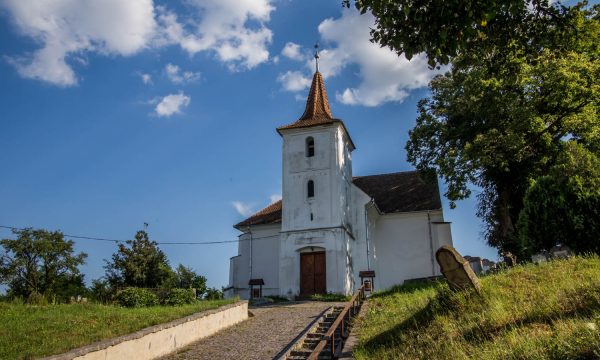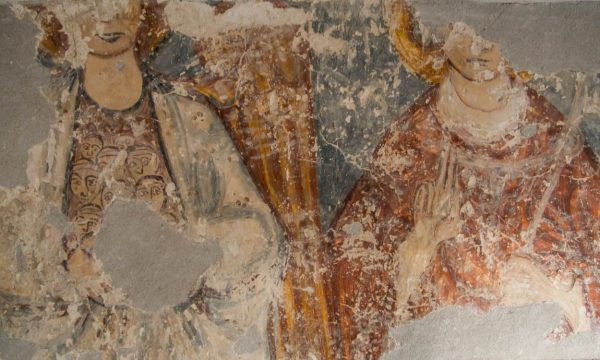Wall painting
“I won’t get into historical debates, whatever the origin of the people who dwelled in the village Pădureni, because each of them turned out as a hearty Szekler Calvinist” – thus thought Balázs Orbán. The scholar dated the village church to the 13th century, and current research supports his assumption. During his visit the coffered ceiling from 1689 was still visible. A few decades later his contemporary, József Huszka was in the process of recording in text and drawing the interior of the church and its painted furniture for his research on Hungarian ornamentations when, together with Géza Nagy, the custodian of the Szekler National Museum, they discovered mural paintings under a layer of lime-wash.

Their discovery of the murals from Pădureni and Ghelința (Hu: Gelence), and later their discovery and published drawings of several other church frescoes in Szeklerland generated a great deal of interest.
In Pădureni, all the scenes of the legend of Saint Ladislau were uncovered intact on the northern wall of the nave, along with several other murals with different themes beneath them. Apart from these, research found another illustration of the Saint Ladislau legend on the western wall of the triumphal arch. The two mural sequences were made in different periods, the first in the 14th century, the second considerably later. Unfortunately, with the departure of the two scholars, most of the murals were destroyed during later interventions, and were preserved only by the drawings of Huszka.

Today, one can see only small traces of the murals on the northern wall of the church nave: the exodus with the unclear figure of some horsemen, and below an interesting Saint Michael depiction.
Natural Heritage
Pădureni is a little village nearby the stream Beșeneu (Hu: Sepsibesenyő), surrounded by the Bodoc mountain (Hu: Bodoki-hegység) in all nuances of the colours: the bald ragstone hills twinkle like silver, the forest-covered mountains are shining in a blue and violet coat, the furthest peaks melt together with the azure of the sky. The Bodoc and Barocchi Mountains Natura 2000 area (ROSPA0082) provides community habitats necessary for the wildlife and plants’ survival. Most of it is covered with a deciduous forest, mostly beech. At the same time, it includes grasslands, meadows, alternating with forest patches, providing an ideal habitat for birds. The special bird conservation area was designated for the protection of 21 bird species. We can observe important populations of predatory birds such as the European honey buzzard (Pernis apivorus) or the lesser spotted eagle (Aquila pomarina) nesting in the forests near the meadows. The latter is a rare, endangered species, and 22% of the world’s population hatches in Romania, most of it in Transylvania. The birds of the beeches are the grey-headed woodpecker (Picus canus), the white-backed woodpecker (Dendrocopos leucotos), the black woodpecker (Dryocopus martius) and the Ural owl (Strix uralensis) all hatch in old, scooped trees. We can see the very rare black stork nesting in the forests (Ciconia nigra), and we can hear the corncrake’s (crex crex) characteristic song in the wet grasslands and meadows. Of the human influences that affect these habitats, the most dangerous is the cutting of trees and the removal of dead wood, and also the transformation of pastures into agricultural areas and the disappearance of wetlands. The area is accessible and can be visited from the village. It can be approached from several directions as we enter from the DC36 main road. Romania’s first dark sky park will be created in the area in the summer of 2017. 8 to 10 locations are suitable for observations, as there is very light pollution here, and one can see the night sky in its natural beauty, so visitors will be able to take part in astronomical tours.
